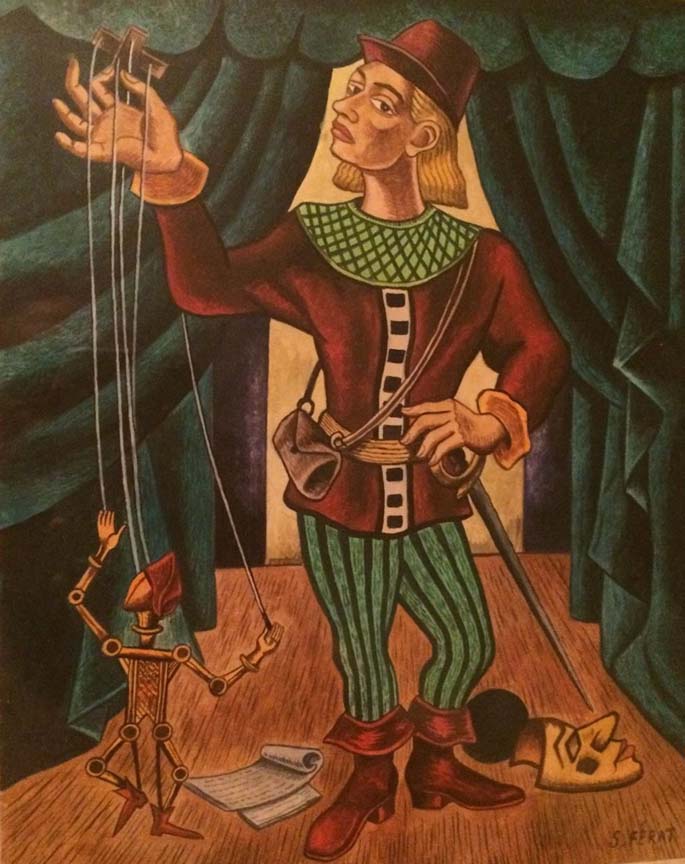
SERGE FERAT
"THE PUPPETEER"
WATERCOLOR GUACHE, SIGNED
RUSSIAN-FRENCH, C.1925
8.5 X 7 INCHES

SERGE FERAT
"THE PUPPETEER"
WATERCOLOR GUACHE, SIGNED
RUSSIAN-FRENCH, C.1925
8.5 X 7 INCHES
Serge Férat 1881-1958 Ferat traveled extensively in his youth to England, France, Italy and Germany. In 1901-1902 he settled, with his sister Baroness d'Oettingen, in Paris, where he took classes with Bouguereau at the Académie Julian. He was also a pupil of Baschet and Schommer. Wealthy and ostentatious, the young Count was surrounded by poets and painters and often attended the night club Le Lapin Agile in Montmartre. He bought many paintings, notably a dozen by the Douanier Rousseau, to whose home in Montparnasse he went for musical evenings. He also acquired works by Picasso and Braque and other Cubist artists. In 1911 he got to know Picasso who introduced him to Apollinaire who became his friend and coined his pseudonym, Férat. It is reputed that Férat bought Soirées de Paris from André Billy, Dalize and Salmon in 1913, and that he financed this journal, in which new ideas were defended. Férat became director and Apollinaire took over the literary direction, and the administration was moved into Férat's sister's apartment at 278 Boulevard Raspail, Paris. T he name Jean Cerusse (from 'Ces Russes' = These Russians: Serge and Hélène) appeared on the cover. The Italian Futurists, in their journal Lacerba, established close relations at that time with Les Soirées de Paris. In 1914 he signed up as a volunteer at the Italian Hospital in Paris and witnessed the wounded Apollinaire arrive there not long afterwards. Ruined by the Russian Revolution, he found himself abandoned by people who had formerly flocked to his parties, where they might meet Picasso, Léger, Cendrars, Jacob, Modigliani and so on. He continued to see only Survage, Gleizes and Delaunay. Disheartened, he destroyed a number of his works but still just managed to continue to live from his art after 1917. Henri Pierre Roché, a man who understood the art of the time, was one of the few people to help him, and Jean Cocteau devoted a monograph to him in 1924. Férat died penniless and unknown in 1958. His paintings from 1910 onwards were inspired by the Italians of the Quattrocento and won favour with Maurice Denis; later Férat became influenced by Cézanne. He knew Picasso, Braque and the other Cubist painters and although he adopted their aesthetics, Férat made them his own, becoming a Cubist of charm and sophistication. His gouaches are particular noteworthy. He produced the programme, sets and costumes for the unique performance of Apollinaire's Mamelles de Tirésias in 1917, which attracted some jealousy from the other Cubists, with the exception of Picasso, and also provided illustrations for Albert Birot's magazine Sic in gouache. The Government commissioned three cartoons for tapestries from him for the Factory in Beauvais. Férat exhibited in Paris under the name of Jastrebzoff at the Salon des Artistes Français, winning an award in 1906, and at the Salon des Artistes Indépendants in 1910, 1911 and 1912 under the pseudonym of Roudniev. He took part in the exhibition of the Section d'Or in Paris in 1920 and exhibited with Max Jacob in 1924. After he took part in the exhibition on Cubism at the Musée d'Art Moderne de la Ville de Paris in 1935, some interest in him re-emerged. He exhibited solo first in 1917 in Paris and in 1938. Férat was represented in 2003 at the collective exhibition Russian Paris 1910-1960, an exhibition on Russian art and artists in Paris organised by the St Petersburg Russian Museum and shown at the Von der Heydt Museum, Wuppertal and at the Museum of Fine Art, Bordeaux. A retrospective was organised at the Galerie Michèle Heyraud in Paris in 1989. |